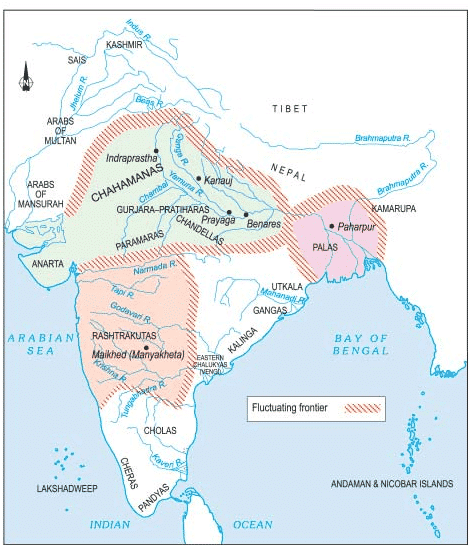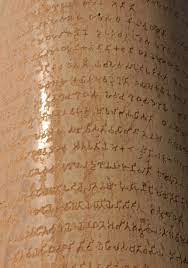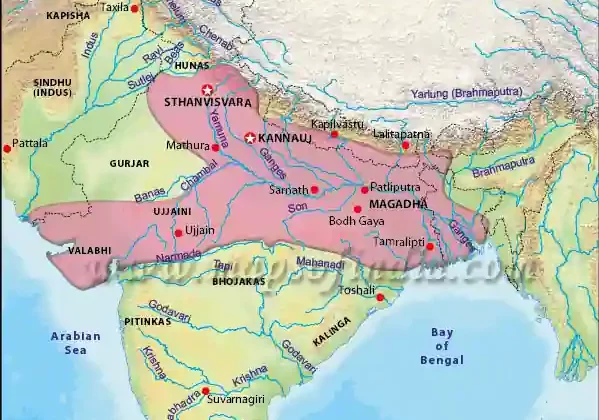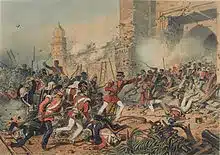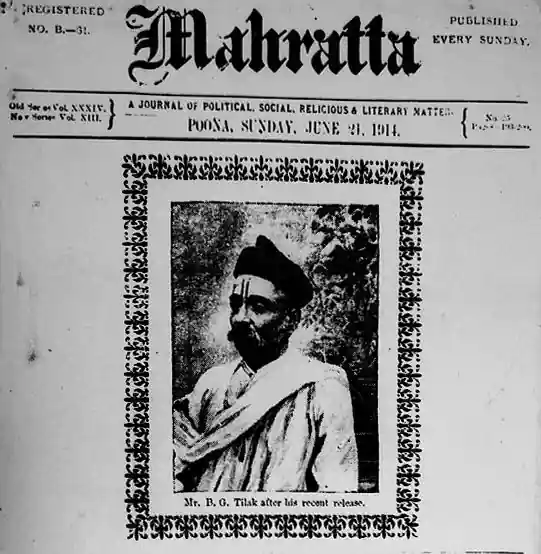Evolution of Mahajanapadas
In the Later Vedic period, people had started agriculture, which made them settle down at a particular place. The new iron agricultural tools and implements (such as the ploughshare) enabled the people to clear thick forest cover and cultivate the hard soil of this area. Also, iron weapons made the warrior class more important.
The janas who migrated eastwards began to settle down in various regions. The loyalty of the people shifted from jana (tribe or clan) to janapada (territory). These permanent settlements led to the foundation of the Janapadas or territorial states, under the control of the king. Janapada literally meant ‘the place where the tribe sets its foot upon.’ The janapadas fought with one another for resources and political dominance. Some janapadas extended their territories and brought various janas within their jurisdiction. Such janapadas grew into mahajanapadas.
- The rise of Janpadas is mainly attributed to the establishment of settled agricultural communities.
- The development of an agriculture-based economy led to increasing in crops and cattle wealth coupled with the use of iron in technology.
- The use of better iron tools and weapons enabled some territorial states to become very large, and they came to be called Mahajanapadas.
- From c. 600 BCE, the political history of India is the history of struggles between these states for supremacy.
List of Mahajanapadas
According to Buddhist texts, Anguttara Nikaya (the land between the Himalayas and Narmada) was divided into 16 independent states (Mahajanapadas). The names of at least 9 among them are given in the Vedic Literature. Panini in the 4th century BC mentions as many as 22 different Janpadas, but also mentions 3 most important viz. Magadha, Kosala and Vatsa.
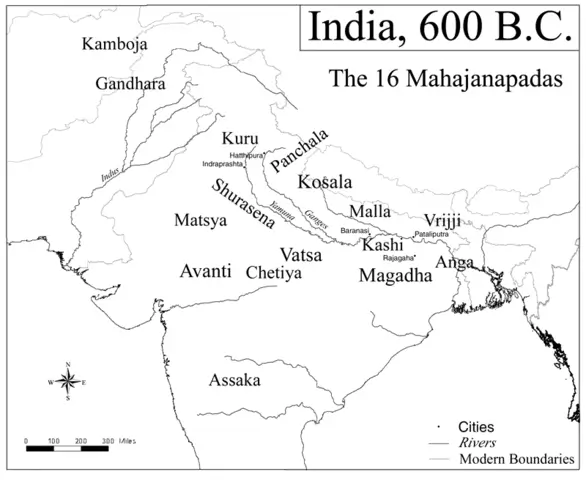
Anga
- Capital: Champa
- Modern Location: Munger and Bhagalpur
- Anga Mahajanapada finds reference in the Mahabharata and Atharva Veda.
- During the rule of Bimbisara, it was taken over by Magadha Empire.
- It is situated in present-day Bihar and West Bengal.
- Its capital Champa was located at the confluence of the Ganga and the Champa rivers.
- It was an important commercial centre on the trade routes and merchants sailed from here to Suvarnabhumi (South East Asia).
Magadha
- Capital: Girivraja/ Rajagriha
- Modern Location: Gaya and Patna
- Magadha finds mention in the Atharva Veda.
- It was located in present-day Bihar close to Anga, divided by river Champa.
- Later, Magadha became a centre of Jainism and the first Buddhist Council was held in Rajagriha.
Kasi/Kashi
- Capital: Kasi
- Modern Location: Banaras
- It was located in Varanasi.
- This city got its name from the rivers Varuna and Asi as cited in the Matsya Purana.
- Kasi was captured by Kosala.
Vatsa
- Capital: Kausambi
- Modern Location: Allahabad
- Vatsa is also known as Vamsa.
- Located on the banks of the Yamuna.
- This Mahajanapada followed the monarchical form of governance.
- The capital was Kausambi/Kaushambi (which was at the confluence of Ganga and Yamuna).
- This was a central city for economic activities.
- Trade and business prospered in the 6th century. After the rise of Buddha, the ruler Udayana made Buddhism a state religion.
Kosala
- Capital: Shravasti (northern), Kushavati (southern)
- Modern location: Eastern Uttar Pradesh
- It was located in the modern Awadh region of Uttar Pradesh.
- The area also included Ayodhya, an important city associated with the Ramayana.
- Kosala also included the tribal republican territory of Sakyas of Kapilavastu.
- Lumbini in Kapilavastu is the birthplace of Gautama Buddha.
- Important king – Prasenajit (Buddha’s contemporary)
Shurasena
- Capital: Mathura
- Modern location: Western Uttar Pradesh
- This place was a centre of Krishna worship at the time of Megasthenes.
- There was a dominance of the Buddha’s followers also.
- Important king – Awantipura (Disciple of Buddha).
- Its capital Mathura was on the banks of the Yamuna.
Panchala
- Capital: Ahichchatra and Kampilya
- Modern location: Western Uttar Pradesh
- Its capital for northern Panchala was Ahichchatra (modern Bareilly) and Kampilya (modern Farrukhabad) for its southern regions.
- The famous city of Kannauj was situated in the Kingdom of Panchala.
- Later the nature of governance shifted from monarchy to republic.
Kuru
- Capital: Indraprastha
- Modern location: Meerut and Southeastern Haryana
- The area around Kurukshetra was apparently the site for Kuru Mahajanapada.
- It moved to a republic form of governance.
- The epic poem, the Mahabharata, tells of a conflict between two branches of the reigning Kuru clan.
Matsya
- Capital: Viratanagara
- Modern location: Jaipur
- It was situated to the west of the Panchalas and south of the Kurus.
- The capital was at Viratanagara (modern Bairat).
- It is situated around the present-day Jaipur, Alwar and Bharatpur areas of Rajasthan.Founder – Virata
Chedi
- Capital: Sothivati
- Modern location: Bundelkhand region
- This was cited in the Rigveda.
- The capital was Sothivati/Shuktimati/Sotthivatinagara.
- It is located in the present-day Bundelkhand region (Central India).
- King – Shishupala.
- Vasudeva Krishna killed him during the Rajasuya sacrifice of the Pandava king Yudhishthira.
Avanti
- Capital: Ujjaini or Mahismati
- Modern Location: Malwa and Madhya Pradesh
- Avanti was significant in relation to the rise of Buddhism.
- The capital of Avanti was located in Ujjaini (northern part) and Mahismati (southern part).
- It was situated around present-day Malwa and Madhya Pradesh.
- Important king – Pradyota.Father-in-law of Udayana (King of the Vatsas).
Gandhara
- Modern location: Rawalpindi
- The capital was at Taxila (Takshashila).
- Present-day location – Modern Peshawar and Rawalpindi, Pakistan and the Kashmir valley.
- Gandhara is cited in the Atharva Veda.
- The people were highly trained in the art of war.
- It was significant for international commercial activities.
- Important king – Pushkarasarin.
- Gandhara was conquered by Persians in the latter part of the sixth century BCE.
Kamboja
- Modern location: Rajouri and Hajra (Kashmir), NWFP (Pakistan)
- The capital of Kamboja was Rajapura (modern Rajauri).
- It is situated in present-day Kashmir and Hindukush.
- Several literary sources mention that Kamboja was a republic.
- Kambojas had an excellent breed of horses.
Asmaka or Assaka
- Capital: Potali/Podana
- Modern location: Banks of Godavari
- It was located on the banks of Godavari.
- It was the only Mahajanapada situated to the south of the Vindhya Range and was in Dakshinapatha.
- It included the region of Pratisthan or Paithan.
Vajji
- Capital:Vaishali
- North of Ganga in the division of Tirhut was the state of the Vajjis.
- It included eight clans, the most powerful being the Lichchhavis (Capital – Vaishali), Videhans (Capital – Mithila), Jnatrikas (based in Kundapura).
- Mahavira belonged to the Jnatrikas clan.
- The Vajjis were defeated by Ajatashatru.
- It was separated from Kosala from river Gandak.
Malla
- Capital: Kusinara
- Modern Location: Deoria and Uttar Pradesh
- It finds a reference in Buddhist and Jain texts and in the Mahabharata.
- Malla was a republic.
- Its territory touched the northern border of the Vajji state.
- Capitals – Kusinara and Pava.Both capitals are important in the history of Buddhism.
- The Buddha took his last meal at Pava and went to Mahaparinirvana at Kusinara.
Political Structure of the Mahajanapadas
Territory, people, government and sovereignty are important elements of a state. All these elements were found in some of the mahajanapadas. The mahajanapadas represented the emergence of territorial kingdoms that ruled over people (jana).
- Most of the states were monarchies but some were republics known as Ganas or Sanghas. These Ganasanghas were oligarchies where the king was elected and he ruled with the help of a council. Vajji was an important Mahajanapada with a Sangha form of government.
- The founders of Jainism and Buddhism came from republican states.
- Each Mahajanapada had a capital city.
- Most of them had forts built around them for protection from other kings.
- Regular armies were maintained by these new kings or Rajas.
- They also collected taxes from the people. Usually, the tax on crops was 1/6th of the produce. This was known as Bhaga or share.
- Even craftsmen, herders, hunters and traders were taxed.
Difference between Gana-Sanghas and Kingdoms
| Gana – Sanghas | Kingdoms |
| 1. The chief office was not hereditary and was known as Ganapati or Ganaraja. | 1. All the powers were vested with the King and his family. |
| 2. The Ganas were located in or near the Himalayan foothills in eastern India. | 2. Majority of the kingdoms occupied the fertile alluvial tracts of the Ganga valley. |
| 3. Representative form of government. The council discussed and debated the issues in a hall, called Santhagara. Salakas (pieces of wood) were used for voting and Salaka-Gahapaka (collector of votes) ensured honesty and impartiality. | 3. Political power was concentrated in the king who was assisted by ministers, advisory councils such as Parishad and Sabha. However, with the emergence of the concept of the divinity of king and more emphasis on priestly rituals, the centrality of the popular assemblies was reduced. |
| 4. The Gana-Sanghas had only two strata- the Kshatriya Rajakula (ruling families) and the Dasa Karmakara (slaves and labourers). | 4. The focus was mainly on caste loyalties and loyalty towards the king. |
| 5. Gana Sanghas were more tolerant than the kingdoms. It is because of this tolerance – Mahavira (Jainism, belonged to Vajji confederacy) and Buddha (Buddhism, belonged to Shakya clan) were able to propagate their philosophy in a more unrestricted way in Gana-Sanghas as compared to Kingdoms. | 5. The Brahmanical political, social and religious theory was more deeply entrenched in the kingdoms. |
| 6. Example: Vajji and Malla. | 6. Example: Magadha, Kosala, Vatsa, and Avanti. |
Related links:


